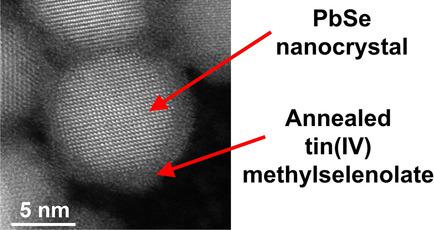当前位置:
X-MOL 学术
›
ChemNanoMat
›
论文详情
Our official English website, www.x-mol.net, welcomes your
feedback! (Note: you will need to create a separate account there.)
Tin(IV) Methylselenolate as a Low Temperature SnSe Precursor and Conductive “Glue” Between Colloidal Nanocrystals
ChemNanoMat ( IF 2.6 ) Pub Date : 2020-01-24 , DOI: 10.1002/cnma.201900650 Prathamesh B. Vartak 1 , Robert Y. Wang 1
ChemNanoMat ( IF 2.6 ) Pub Date : 2020-01-24 , DOI: 10.1002/cnma.201900650 Prathamesh B. Vartak 1 , Robert Y. Wang 1
Affiliation

|
We report the synthesis of a soluble precursor that transforms into crystalline SnSe at 200 °C. This transformation temperature is significantly lower than the 270–350 °C range of previously reported tin selenide precursors. This precursor is synthesized by reacting tin with dimethyl diselenide and we identify the precursor as tin(IV) methylselenolate using a combination of mass spectrometry, Raman spectroscopy, and nuclear magnetic resonance spectroscopy. We then chemically treat PbSe colloidal nanocrystals with this precursor and subject them to mild annealing. We characterize the chemical and structural changes during this processing using infrared spectroscopy, aberration‐corrected scanning transmission electron microscopy, and X‐ray photoelectron spectroscopy. These characterization studies indicate the successful formation of a SnSe‐like material that fills the interstitial space between the PbSe nanocrystal cores. We find that the electrical conductivity of these nanocrystal films is comparable to other excellent treatments used to improve charge transport. This excellent charge transport demonstrates the utility of tin(IV) methylselenolate as a conductive “glue” between nanocrystals.
中文翻译:

甲基硒酸锡(IV)作为低温SnSe前体和胶体纳米晶体之间的导电“胶”
我们报告了在200°C下可转变成结晶SnSe的可溶性前体的合成。该转变温度明显低于先前报道的硒化锡前体的270-350°C范围。该前体是通过锡与二甲基二硒化物的反应合成的,我们通过质谱,拉曼光谱和核磁共振光谱的组合将前体鉴定为甲基硒化锡(IV)。然后,我们用该前体化学处理PbSe胶体纳米晶体,并对其进行温和退火。我们使用红外光谱,像差校正的扫描透射电子显微镜和X射线光电子能谱来表征此过程中的化学和结构变化。这些表征研究表明成功形成了一种SnSe样材料,该材料填充了PbSe纳米晶核之间的间隙。我们发现这些纳米晶体薄膜的电导率可与其他用于改善电荷传输的出色处理相媲美。这种出色的电荷传输证明了甲基硒酸锡(IV)在纳米晶体之间作为导电“胶水”的实用性。
更新日期:2020-01-24
中文翻译:

甲基硒酸锡(IV)作为低温SnSe前体和胶体纳米晶体之间的导电“胶”
我们报告了在200°C下可转变成结晶SnSe的可溶性前体的合成。该转变温度明显低于先前报道的硒化锡前体的270-350°C范围。该前体是通过锡与二甲基二硒化物的反应合成的,我们通过质谱,拉曼光谱和核磁共振光谱的组合将前体鉴定为甲基硒化锡(IV)。然后,我们用该前体化学处理PbSe胶体纳米晶体,并对其进行温和退火。我们使用红外光谱,像差校正的扫描透射电子显微镜和X射线光电子能谱来表征此过程中的化学和结构变化。这些表征研究表明成功形成了一种SnSe样材料,该材料填充了PbSe纳米晶核之间的间隙。我们发现这些纳米晶体薄膜的电导率可与其他用于改善电荷传输的出色处理相媲美。这种出色的电荷传输证明了甲基硒酸锡(IV)在纳米晶体之间作为导电“胶水”的实用性。











































 京公网安备 11010802027423号
京公网安备 11010802027423号